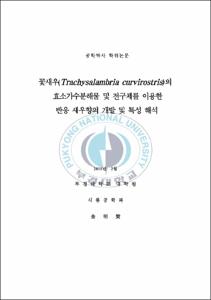꽃새우(Trachysalambria curvirostris)의 효소가수분해물 및 전구체를 이용한 반응 새우향의 개발 및 특성 해석
- Alternative Title
- Development and Quality Characteristics of Shrimp-type Reaction Flavor Using Enzymatic Hydrolysates of Spotted Shrimp (Trachysalambria curvirostris) and Precursors
- Abstract
- Shrimp appears to be an alternative fishery resource because of the reduction of fish resource, which represents the primary catching of fish around the Yellow and Southern Seas in Korea, and particularly, the share of big size oriental shrimp, medium size shiba shrimp and spotted shrimp catches takes over 50% of total shrimp catch. Meantime, the natural odor of crustacea such as shrimp does spread an unique flavor which is quite different from those of mammalian meats. When stored for a long time, the unique odor is to fade away stinking with strong fish odor and off-flavor due to its decreased freshness.
This study intends to develop a shrimp reaction flavor which is capable of enhancing the favorite taste sensually by masking the fishy odor and off-flavor and by reinforcing the unique flavor of shrimp through Maillard reaction process using the shrimp hydrolysate and reactive precursors. In this study, the objectives are to optimize the enzymatic hydrolysis condition of shrimp as the pre-treatment process for shrimp reaction flavor production; to determine optimum precursors and reacting condition, which remove fish odor of the seafood inherent but further reinforce good shrimp flavor; finally to develop boiled-type shrimp reaction flavor used in the seafood sauces and fish meat paste and grilled-type reaction shrimp flavor used in the production of snack and seasoning. In order to obtain the optimum hydrolysis condition of spotted shrimp by the type of enzymes, the two independent variables of reaction pH and temperature are selected based on the central composite design system designating the hydrolysis and anti oxidation efficiencies as dependent variables by using a response surface methodology. The optimum hydrolysis conditions for proteolytic enzymes such as Alcalase, Flavourzyme, Protamax and Nutrase were pH 9.3 and 65.2℃, pH 4.1 and 54.5℃, pH 6.6 and 42.5℃, pH 6.1 and 45.2℃, respectively. Among the four enzymes, Alcalase showed the best anti oxidative activities of 24.9% DPPH-scavenging activity and 26.9% Fe-chelating activity.
Depending on the application purpose, boiled-type shrimp reaction flavor of producing the boiled flavor used in instant noodle soup and seafood sauce, and grilled-type shrimp reaction flavor used in the flavoring, snacks and cookies are manufactured. To manufacture boiled-type shrimp reaction flavor, methionine and sucrose are selected as reaction precursors designating the reactive manufacturing condition as pH 7.5 and 1hr reaction time. To manufacture grilled-type shrimp reaction flavor, methionine, threonine, glucosamine and xylose were selected as reaction precursors designating the reactive manufacturing condition as pH 7.5 and 2hr reaction time.
Upon executing the analysis on the volatile contents of sulfides and pyrazines which are presumed to further reinforce the unique shrimp flavor, no sulfides and pyrazines are identified from the hydrolyzate. From the boiled-type shrimp reaction flavor, two sulfur-containing compounds of dimethyl disulfide and dimethyl trisulfide and two nitrogen-containing compounds of 2,5-dimethyl pyrazine and 2,3-dimethyl pyrazine were identified. From the grilled-type shrimp reaction flavor, dimethyl disulfide and 7 pyrazines of pyrazine, methyl pyrazine, 2,5-dimethyl pyrazine, 2,3-dimethyl pyrazine, 2-ethyl-5-methyl pyrazine, trimethyl pyrazine and tetramethyl pyrazine were identified.
The boiled-type and grilled-type shrimp reaction flavors were made in the shapes of extracts and powders with the different mixing ingredients for pure type and seasoning type. The extracts were dried by vacuum drying, spray drying and freeze drying. The powders of grilled-type did show no sensory difference in terms of drying methods. As well, the comprehensive sensory score of seasoning type proved to be better than the pure type.
- Issued Date
- 2011
- Awarded Date
- 2011. 2
- Type
- Dissertation
- Publisher
- 부경대학교
- Affiliation
- 부경대학교 대학원
- Department
- 대학원 식품공학과
- Advisor
- 김선봉
- Table Of Contents
- 서 론 1
재료 및 방법 6
1. 실험재료 6
1.1 꽃새우 6
1.2 반응전구체 6
1.3 효소 및 시약류 6
2. 실험방법 7
2.1 일반성분, pH 및 휘발성 염기질소(VBN)의 측정 7
2.2 지방산의 분석 7
2.3 유리아미노산의 분석 7
2.4 휘발성 성분의 분석 9
2.5 효소 가수분해물의 제조 10
2.6 가수분해도 측정 10
2.7 DPPH-Scavenging 및 Fe-Chelating activity 측정 14
2.8 최적가수분해 조건설정 및 통계분석 15
2.9 반응전구체를 이용한 반응 새우향의 제조 15
2.9.1 Boiled-type 반응 새우향 18
2.9.2 Grilled-type 반응 새우향 18
2.10 반응 새우향 제품의 제조 21
2.10.1 제품 제조의 원료 배합비 21
2.10.2 제품 형태에 따른 제조 방법 25
2.11 관능 평가 및 통계 처리 28
결과 및 고찰 29
1. 꽃새우의 성분 조성 29
1.1 꽃새우의 일반성분, pH 및 VBN 29
1.2 지방산 29
1.3 유리아미노산 31
2. 효소의 종류에 따른 꽃새우의 가수분해 최적화 33
2.1 시간에 따른 효소 농도별 가수분해 33
2.2 Alcalase 36
2.3 Flavourzyme 48
2.4 Protamax 58
2.5 Neutrase 68
3. 반응 새우향의 제조를 위한 반응 조건 해석 78
3.1 Boiled-type 반응 새우향 78
3.1.1 Amino acid의 선택 78
3.1.2 Sugar의 선택 79
3.1.3 pH 조건 설정 79
3.1.4 반응시간 설정 80
3.2 Grilled-type 반응 새우향 89
3.2.1 Amino acid의 선택 89
3.2.2 Sugar의 선택 90
3.2.3 pH 조건 설정 91
3.2.4 반응시간 설정 91
4. 반응 새우향의 휘발성 성분의 해석 104
4.1 Boiled-type 반응 새우향 104
4.2 Grilled-type 반응 새우향 112
4.3 주요 휘발성 성분의 생성 기작 119
4.3.1 Sulfide류의 생성 기작 119
4.3.2 Pyrazine류의 생성 기작 119
5. 반응 새우향의 제품화 127
5.1 분말(Powder) 제품의 관능 평가 127
5.2 액상(Extract) 제품의 관능 평가 127
요 약 132
감사의 글 136
참 고 문 헌 138
- Degree
- Doctor
- Files in This Item:
-
-
Download
 꽃새우(Trachysalambria curvirostris)의 효소가수분해물 및 전구체를 이용한 반응 새우향의 개발 및 특성 해석.pdf
기타 데이터 / 2.47 MB / Adobe PDF
꽃새우(Trachysalambria curvirostris)의 효소가수분해물 및 전구체를 이용한 반응 새우향의 개발 및 특성 해석.pdf
기타 데이터 / 2.47 MB / Adobe PDF
-
Items in Repository are protected by copyright, with all rights reserved, unless otherwise indicated.